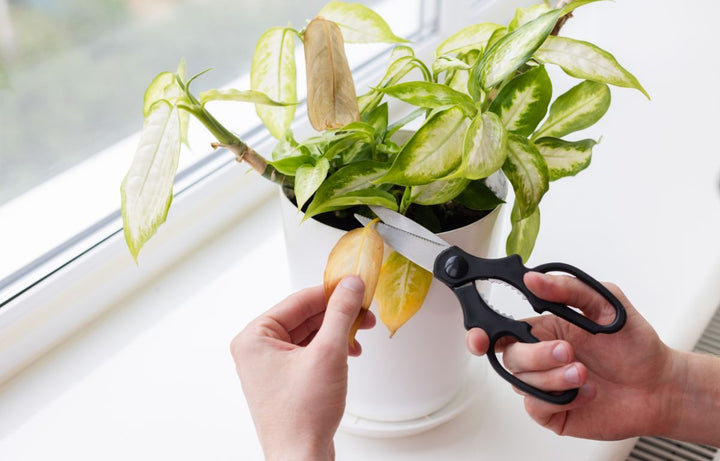
SOS Keep or Remove: Infected Foliage
SOS Keep or Remove: Infected Foliage
Houseplants bring life and beauty into our homes, but they can also be susceptible to various diseases. When a plant shows signs of infection, such as discoloured or wilting leaves, gardeners face a crucial decision: Should the infected foliage be kept or removed? Each approach has its benefits and risks, and understanding them is vital for maintaining healthy plants.

Keeping Infected Foliage
Benefits
Natural Healing: In some cases, plants can recover from mild infections on their own. Keeping the foliage gives the plant a chance to heal naturally. Keep in mind that some discolouration may be normal if the plant goes dormant during the cooler months of the year. This foliage should return to its normal colouring once temperatures increase.
Photosynthesis Preservation: Leaves, even if partially infected, still contribute to photosynthesis, which is essential for the plant's growth and energy production.
Minimal Stress: Removing leaves can stress a plant, especially if a significant portion of its foliage is removed. Keeping the infected leaves can help avoid additional stress.
Monitoring Disease Progression: By keeping the infected foliage, gardeners can monitor the disease progression and better understand the plant's response to various treatments.
Risks
Spread of Disease: Infected foliage can be a source of further disease spread within the plant or to neighbouring plants. Fungal spores, bacteria, or viruses can easily move from leaf to leaf.
Aesthetics: Infected leaves often look unsightly, detracting from the plant's overall appearance and the aesthetic appeal of the home.
Delayed Action: Keeping infected leaves might delay necessary actions, allowing the disease to progress to a more severe stage where it becomes harder to control.
Unpleasant Odour: Diseased foliage often smells bad due to bacterial or fungal growth, which produces unpleasant odours as the plant tissue decays.

Removing Infected Foliage
Benefits
Disease Control: Removing infected leaves can significantly reduce the spread of pathogens, preventing the disease from affecting the entire plant or spreading to other plants.
Improved Plant Health: By removing the source of infection, the plant can direct its energy towards new growth rather than trying to sustain diseased leaves.
Aesthetic Improvement: Pruning away infected foliage that is already dying or dead immediately enhances the plant's appearance, making it look healthier and more attractive.
Preventing Secondary Infections: Diseased leaves can attract pests or secondary infections. Removing them reduces this risk.
Risks
Potential Stress: Removing partially infected leaves, especially a large number, can stress the plant, potentially impacting its overall health and growth. It is generally recommended to avoid heavy pruning during the autumn and winter months when growth is naturally slowed, and the plant goes into its dormant cycle.
Reduced Photosynthesis: Fewer leaves mean less surface area for photosynthesis, which can slow the plant's growth and vitality, taking longer to produce new foliage.
Risk of Over-Pruning: There's a risk of removing too much foliage, which can harm the plant more than the disease itself, particularly if the plant is already weakened or dormant. In addition, the removal of larger mature foliage may expose delicate new growth to damaging pests, harsh sunlight, heavy rain and winds.

Finding a Balance
Deciding whether to keep or remove infected houseplant foliage depends on the specific situation and the severity of the infection. Here are some general guidelines to help you make an informed decision:
Regular Maintenance and Care: First and foremost, regularly maintain and care for your plant, including providing adequate light, appropriate watering, humidity consistency, and fertilising as required. This is the best way to ensure your plant is healthy, reducing the risks of problems like infection. Make sure your plant is not exposed to the usual problems such as cool draughts, dry air heating, low or harsh light levels, and over or underwatering.
Assess the Severity: For mild infections, it might be beneficial to monitor the plant and see if it can recover on its own. It might be that the plant is lacking water, sunlight or nutrients. If this is the case, you should see improvement within a few weeks once rectified. For severe infections, the prompt removal of infected foliage is usually the best course of action to prevent its spread to healthy parts of the plant.
Isolate the Plant: If you keep infected foliage, isolate the plant to prevent contaminating other plants in your collection.
Prune Carefully: If you remove infected leaves, do so carefully to minimise stress. Use clean, sterilised tools to prevent the spreading of pathogens. After pruning, dispose of infected foliage in the waste. Do not put it in your compost or on your garden bed.
Monitor and Treat: Regardless of your choice, always monitor your plant closely and apply appropriate treatments, such as fungicides or insecticides as soon as signs appear. Even if you remove the infected foliage, it is good to treat the whole plant.
Ultimately, the health and well-being of your houseplants depend on timely and thoughtful care. By understanding the benefits and risks of keeping or removing infected foliage, you can make the best decision for your plants and enjoy a healthy and thriving indoor garden all year round.
